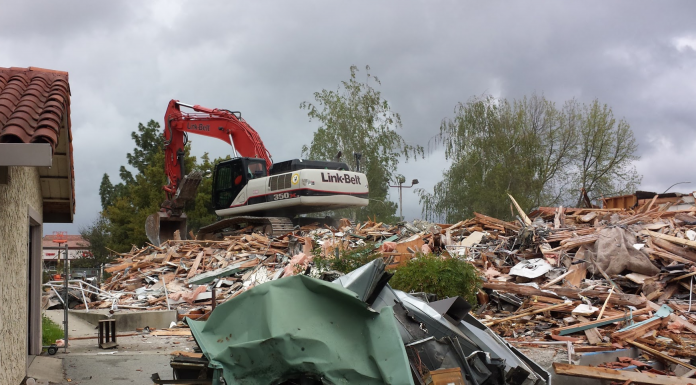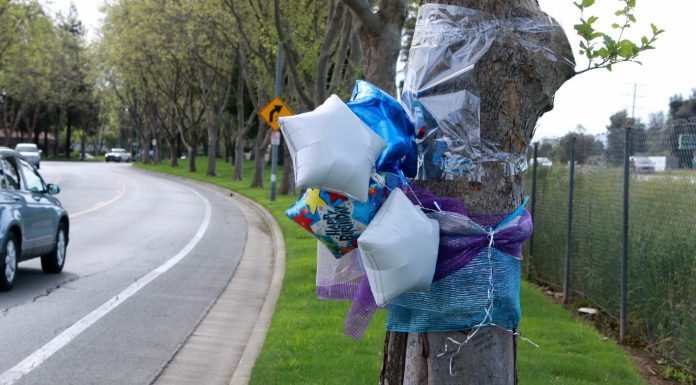They Look Identical; Write Differently
Writing a book is a major accomplishment. But if you are 23 years old, have an identical twin, have written the book together and have published your first in a series of young adult novels, that is astounding.Brittany and Nicole Pettibone spent their early years in Kansas, before moving to Morgan Hill over a decade ago. They are known in the literary world as T.S. Pettibone, a pen name created by using the first letters of their parents’ names, Theodore and Sabrina.The twins attended freshman year at Thomas More High School in San Jose. The following year Nicole traveled to New York, where she attended a boarding school, while Brittany remained at home.It was an experiment of sorts as the twins wanted to experience life apart.“We realized that we’re better together,” Brittany said.“We feel we complement each other, although we’re very different,” Nicole added.Three years ago the Pettibone family, with 10 kids, moved to Gilroy, and in January the twins completed their first book, Hatred Day, in the young adult (YA) fantasy/sci-fi genre.The Gilroy community can meet these local celebrities on Saturday, April 2 at 3 p.m., when the Pettibone twins appear at Gilroy Library to read from Hatred Day.The library visit is something the twins look forward to; they see it as an opportunity to meet avid readers of YA fiction.As it happens, Brittany and Nicole are not only identical twins; they are mirror image twins.Many of their physical traits are exact opposites of each other, such as Brittany being left-handed, and Nicole being right-handed. The same can be said for their personalities.“I was more outgoing when we were younger, and Nicole was more withdrawn—not really shy, just withdrawn—and her focus was on writing,” Brittany said.“For example in writing, [Nicole] has strengths where my weaknesses are, and my strengths are where her weaknesses are,” Brittany said, adding, “I can see things more broadly, like plotwise, and she’s better at the details and dialogue. It really works.”The girls don’t consider their relationship any different from other sibling relationships, although they’ve been told otherwise.“People have commented that they find us as unapproachable because we have that twin bond, and we’re always talking,” Nicole said.The twins admit they’ve had fun with the fact that they are identical. When they were in second grade, Brittany, the eldest by 15 minutes, proposed the idea of switching identities, they wanted to see if their teachers would notice.The ruse worked, and for three days the twins pulled it off.Throughout their grade school days Brittany spent most of her time with friends and playing sports, while Nicole created her own world through her art and her writing.“The things I imagined, or the things that moved me, I loved to be able to put into physical form,” Nicole said. “It’s sort of without leaving the house you’re exploring on your own. You’re building worlds, you’re learning and discovering new things.”It wasn’t until the 10th grade that Nicole decided to share her writing with her sister.“I was mesmerized by it. I loved it,” Brittany said.Inspired by Nicole’s work, Brittany tried her hand at writing and formulated the premise for their first book, a sci-fi/fantasy thriller set in 2052.“It was absolutely terrible back then,” said Brittany. “We were about 15 when we thought of the idea for the story, but Nicole actually wanted to write it with me because she saw some potential in it.“We didn’t have the theme, we didn’t have moral arguments, and all these kind of things way back then, and our characters were completely different too.”The twins explained that the idea of the main character, a teenaged girl, volunteering to be bait for a hunt, is the only aspect of the story that has stayed consistent.Many might be surprised to discover that writing together is something the twins really enjoy, and according to them, they rarely argue.“Normally, for the most part, we agree,” Brittany, said.They also agree on the genre of their writing, which is centered in the world of fantasy.“We’ve always loved the idea of no limitations. We loved the idea of being able to do what we want, to do really imaginative and crazy things in our book,” Nicole said.The twins love writing so much they admit that it has been a stumbling block for them.“Honestly we feel that we can always do better, we’re never satisfied,” Nicole said. “We just kind of have to cut the cord at some point and end it, because otherwise we’d probably write a million times, until we’re like old, and never get it out.”When it came to their writing process for the first book, the twins would brainstorm for hours; then each would write their own draft of the story. The process turned out to be very counterproductive, as they wound up with over 20 revisions. It wasn’t until they created an outline for the story, which provided structure to their writing, that it all came together.Hatred Day, released on Jan. 29, is the first installment of the authors’ planned seven-book series. They also aim to write two stand-alone books. The projected completion date for all nine books, according to the twins, is in five years, if not sooner.“Our long range goal is within three to five years to be able to fully support ourselves. That would be the ultimate thing for us, and it’s what we’ve been working towards for so long,” Brittany said.Even with numerous offers from publishers, after a great deal of deliberation the twins decided to go the route of self-publishing.“We like doing it on our own. We wanted to do everything ourselves,” Nicole said.“It is getting a lot more credibility, self-publishing, and it’s a lot easier to do than it was just a few years ago,” Brittany said. “Now a lot more people are open to it.”“I think that YA is mainly in that age [15-19], where you have a lot of firsts in life, you try a lot of new things,” Nicole said.“We don’t actually have that in our book,” she continued, “because they are in such a ruthless world, and they have to survive from a young age, and have to mature more quickly. So ours isn’t really coming of age, but there will be, throughout the series, there will be a lot of firsts, because it’s about growing up, first heartbreaks, and so on.”For more information about the Hatred Day series, visit the authors’ website at:http://tspettibone.com.
Gilroy Man Was First Alameda Hispanic Firefighter
He was by all accounts the perfect firefighter, a good husband and dad, a quiet man of strength and courage who never boasted, loved toy trains and put his life on the line for others.And Ruben Gomez also was the first Hispanic firefighter in Alameda County.In the on-again, off-again rainstorm of March 11, they laid Fire Capt. Gomez to rest in Gilroy, the town in which he was raised, one of 18 children. He was 82.So special was his memory to those with whom he served in the Alameda Fire Department for 26 years that more than two dozen of its active and retired firefighters attended the funeral at St. Mary Roman Catholic Church on First Street.And although Gomez had retired to San Martin in 1991, a gleaming red Alameda Fire Department ladder truck made the 90-minute drive to Gilroy to represent that city’s appreciation for his long service, which included an award for valor for risking his own life to save a brother firefighter’s life. It was an incident he never even mentioned to his family until it came out in an awards ceremony, to his wife’s great surprise.Members of Gomez’s family, including four children, some of his 12 grandchildren, 27 great-grandchildren and scores of friends filled the church for the funeral Mass and the burial at St. Mary Cemetery.“He was such a kind man,” said his wife of 62 years, Melicia, 79, who’s known as Millie. They met at a dance in Gilroy, after her future husband had moved with his family to California from El Paso, Texas, in 1942 and she had moved to Gilroy from Brawley.Ruben Gomez graduated from Gilroy High School in 1953; he and Millie were married the same year at St. Mary’s Church.His widow described Ruben as a man who loved dancing, from Mexican to swing, and looked forward each year to a hunting trip with fellow firefighters to Colorado or Idaho.“Hunting season, that was his thing,” she said, adding, “It was just wonderful for him to go.”His other love was toy trains, which he collected with relish, scouring yard sales and flea markets for collectable engines and cars, according to his family.Daughter Maria Gomez, 51, of Morgan Hill agreed, describing her dad as dark-haired, light-skinned with brownish-greenish eyes and always on the thin side.“He was very quiet and very strict with us kids. He came from a generation that did not show a lot of emotion” so he showed his love and affection by doing for others, she said.In her case, it was to teach her all he knew about working around the house and on cars, to the point that she loved doing mechanical work on her own car and knew he’d be quick to pitch in, saying, “get out of the way, you’ll make a mess,” she said.He bought Maria her first car, a 1955 Chevrolet, when she was 12. She said she still has it.“That is how he showed affection, by doing things for you; he was always willing to help someone out,” she said.The couple’s other children are Barbara Burrows of Livermore, Ruben Gomez, Jr. of Van Nuys and David Gomez of San Martin.Gomez was diagnosed with Parkinson’s disease six years ago and it took his life, Maria Gomez said.After marrying, the newlyweds moved to Oakland, and later to Hayward, where Gomez worked for Babcock Manufacturing, a fabricator of workshop vises. It was there that a foreman urged him to take the test for the Alameda Fire Department.He was hired in 1964 but kept working part-time for Babcock and worked the two jobs until he retired in 1991, Maria said.“He’d walk in the house in his fire department uniform and go into his room and come out in his street clothes and go to his part-time job,” she said, recalling their days in Hayward.When her parents in 1991 wanted to “come home” to South County and relocated to San Martin, she followed them to Morgan Hill, Maria said.And while he never boasted or bragged about it, she said the family is very proud of the fact that he was the first Hispanic firefighter in Alameda County.“There was still a lot of prejudice at that time,” she said.By all accounts, Ruben Gomez had a reputation for selfless courage on the fire line, a great sense of humor with his brother firefighters—and for being a terrific cook in the firehouse.None of which he shared with his family.He was quiet and reserved, Maria said, and he never shared in kitchen duties at home. So it came as a complete surprise when his fellow firefighters revealed he had a terrific sense of humor, cooked the best Mexican food and earned a medal for valor in the line of duty.The latter went unknown to his family until Ruben told Millie they had to attend an awards ceremony—where, it turned out, he received a medal of valor for pulling an unconscious partner from a burning and smoke-filled building.Millie Gomez recounted how her husband and his partner were nearly overcome by smoke in the pitch-black dark of the building and had to feel their way along the walls for an exit. After making it out and to a nearby fence, Ruben turned to see his partner was not behind him. He returned to the burning building and, groping in the dark, located his unconscious partner and pulled the man to safety, she said. At the ceremony, his tearful partner thanked Gomez for saving his life.At the Alameda Fire Department, Chief Doug Long remembered Gomez as “very competent and knowledgeable man, quiet and soft spoken” and someone people liked to be around. He was held in the highest regard, Chief Long said.Long and Gomez served together for three years during Gomez’s tenure from August 15, 1964 to Oct. 1, 1991.So devoted was he to the fire service that his widow wanted him to be buried in his fire captain’s jacket, but was terribly conflicted because she also wanted to keep the jacket among the memories of her husband.She asked if the jacket could be put on her husband for the funeral, then be returned to her before the burial, but was told that to put the garment on him it would have to be cut all the way up the back and fitted onto him. She could not do that to the jacket.Maria Gomez said that after she shared her mother’s quandary with the Alameda Fire Department, three firefighters sent their own jackets to be used, her aunt did a few alterations on one, including making copies of adornments specific to her father’s uniform, and Capt. Ruben Gomez, Alameda County’s first Hispanic firefighter, was buried in one those.
Converse Party Friday
Cons are cool again and the Converse store at the Gilroy Outlets is giving away gift cards selling sneakers at half off and throwing a party with live music Friday to celebrate the doubling of the store's size.The store is growing from 1,100 square-feet to 2,300 square-feet in Building B. The grand opening will be Friday, March 25 with live music, hourly gift card raffles from 1 to 5 p.m., and deals like sneakers buy one, get one 50 percent off. Shoppers can look forward to fresh styles for the All Star, Cons and Jack Purcell. For more up-to-date news and events, follow Gilroy Premium Outlets on Twitter and Facebook.
McDonald’s Honors Gilroyan
Carmen Jimenez, 36, general manager of the McDonald’s restaurant at 797 First St. in Gilroy, will receive the prestigious Ray Kroc Award, named after the fast food chain founder in 1999 to honor high performing restaurant managers from across the globe.
Gilroy’s Public Garden has a big Impact
Recent rains have left their mark on Gilroy, overflowing local waterways and making a tourist attraction out of the flooding on Miller Avenue at Christmas Hill Park.
A Piece of Gilroy History Knocked Down for a CVS
Demolition began this week for a sprawling new CVS pharmacy at one of Gilroy’s busiest corners—and the site of its first salad bar.
Parents of Dead Teen Want to Make Arroyo Safer
Rebecca Plaza celebrated what would have been her son’s 20th birthday by placing a picture of him with a cake on the tree on Arroyo Circle where he died a year earlier.
PHOTO: Chamber Builds Bridge, Sees Wall
BREAKING WALLS Gilroy’s Chamber of Commerce has a new touch, a statue calling attention to a trip to China. The nine-day trip from Oct.16-24 goes for $2,199 for Chamber members, $2,299 for non-members. Travelers will see Beijing, Shanghai, Suzhou and Hangzhou. The Chamber got the statue of a Terracotta warrior from Citslinc, the company arranging the trip and will donate it after the trip to Gilroy Gardens.
Fit for a Princess
Walking into the historic Willey House on Fifth Street in downtown Gilroy last Saturday, the infectious laughter of little girls greets you, second to the sweet scent of hair spray and perfume.























